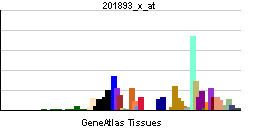Entrez 1634 | Ensembl ENSG00000011465 | |
 | ||
Aliases DCN, Dcn, DC, DSPG2, PG40, PGII, PGS2, SLRR1B, mDcn, CSCD, decorin External IDs MGI: 94872 HomoloGene: 22430 GeneCards: DCN | ||
Decorin is a protein that in humans is encoded by the DCN gene.
Contents
Decorin is a proteoglycan that is on average 90 - 140 kilodaltons (kDa) in molecular weight. It belongs to the small leucine-rich proteoglycan (SLRP) family and consists of a protein core containing leucine repeats with a glycosaminoglycan (GAG) chain consisting of either chondroitin sulfate (CS) or dermatan sulfate (DS).
Decorin is a small cellular or pericellular matrix proteoglycan and is closely related in structure to biglycan protein. Decorin and biglycan are thought to be the result of a gene duplication. This protein is a component of connective tissue, binds to type I collagen fibrils, and plays a role in matrix assembly.
Naming
Decorin's name is a derivative of both the fact that it "decorates" collagen type I, and that it interacts with the "d" and "e" bands of fibrils of this collagen.
Function
Decorin appears to influence fibrillogenesis, and also interacts with fibronectin, thrombospondin, the complement component C1q, epidermal growth factor receptor (EGFR) and transforming growth factor-beta (TGF-beta).
Decorin has been shown to either enhance or inhibit the activity of TGF-beta 1. The primary function of decorin involves regulation during the cell cycle.
It has involved in the regulation of autophagy, of endothelial cell and inhibits angiogenesis. This process is mediated by a high-affinity interaction with VEGFR2 ( vascular endothelial growth factor receptor) which leads to increased levels of tumor suppressor gene called PEG3. Other angiogenic growth factors that decorin inhibits are angiopoietin, hepatocyte growth factor (HGF) and platelet-derived growth factor (PDGF).
Decorin has recently been established as a myokine. In this role, it promotes muscle hypertrophy by binding with myostatin.
Clinical signifiance
Keloid scars have decreased decorin expression compared to healthy skin.
Animal studies
Infusion of decorin into experimental rodent spinal cord injuries has been shown to suppress scar formation and promote axon growth.
Decorin has been shown to have anti-tumorigenic properties in an experimental murine tumor model and is capable of suppressing the growth of various tumor cell lines. There are multiple alternatively spliced transcript variants known for the decorin gene. Mutations in the decorin gene are associated with congenital stromal corneal dystrophy.
Interactions
Decorin has been shown to interact with:
